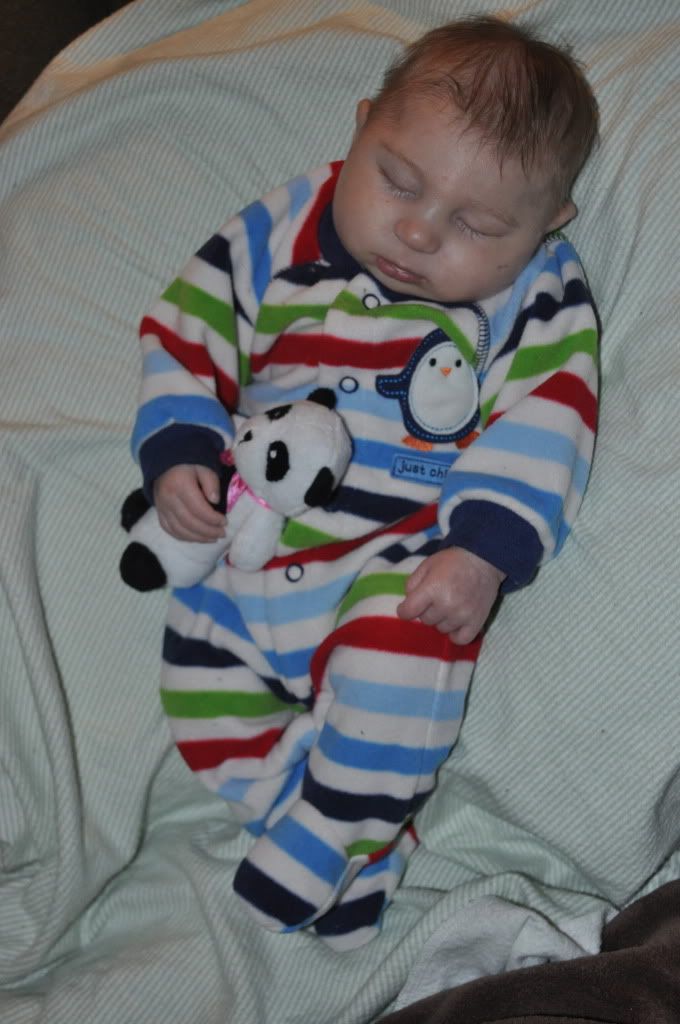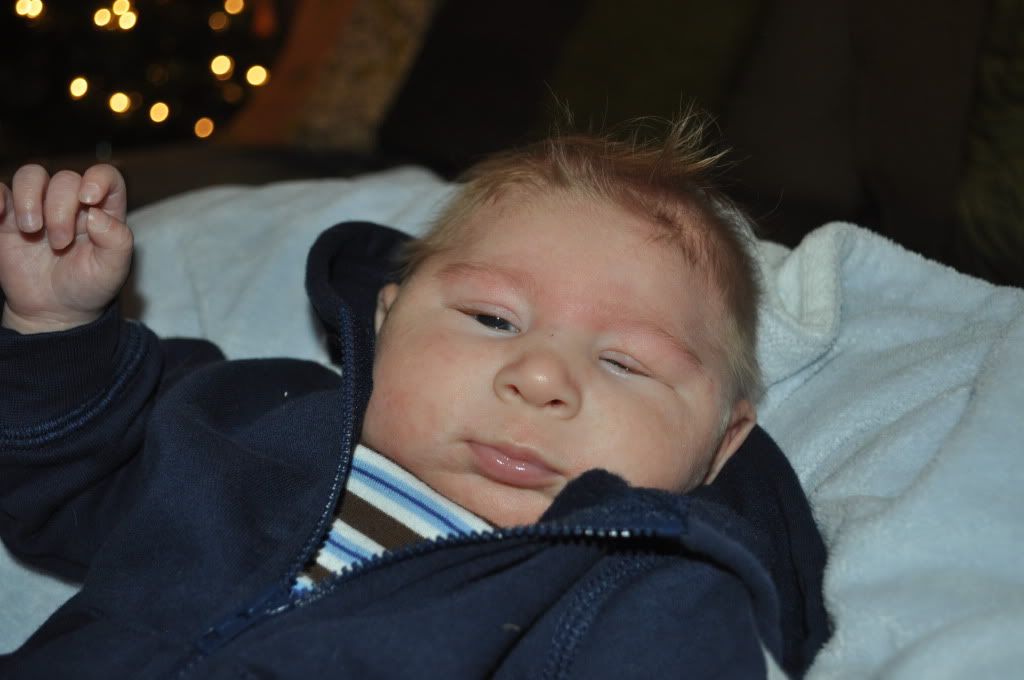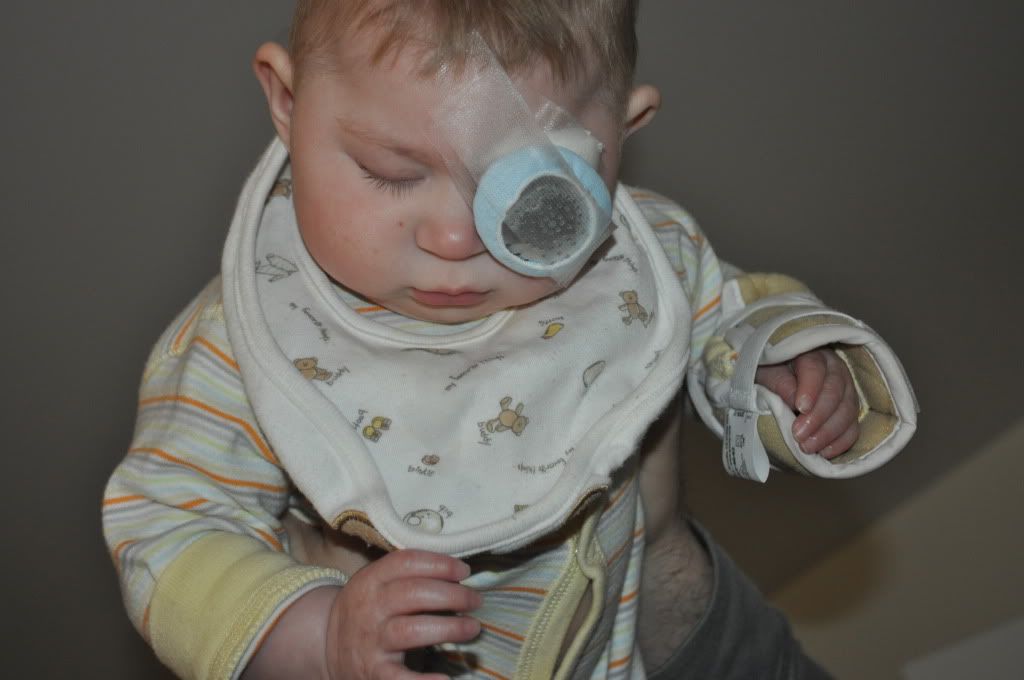 |
| Tommy, back then. |
Our first visit to that building was a retinal evaluation scheduled by our pediatric ophthalmologist after her in-office exam and ultrasound of Thomas' eyes. Tom was five-days-old on that first visit. Everyone else in the warm and crowded waiting room was a senior citizen, so our brand new baby really stood out. You could tell everyone was wondering why a baby would be seen in that office but everyone was too kind to ask - that time.
A lot of elderly people need to see retinal specialists for problems like macular degeneration and other retinal problems associated with age. It was always hard for me when the middle-aged children of these elderly patients used us as an example, "Look at that baby. He has eye problems. You got to see your whole life so stop complaining!" Hey, thanks for using our tough situation as a teaching moment in the middle of the waiting room. Really. That was great, but back to the story of our first visit.
 |
| A very new Tommy. I loved dressing him in little boy style clothes instead of sleepers. |
We really had no idea that Tom was completely blind at that point. Shortly after Tom's birth, a NICU developmental specialist told us that he had no visual response. We were told it could be anything from a cateract to a type of tumor called a retinoblastoma, but a more through exam was needed to find out. We knew he could not see at that moment but we did not know that his eye condition could not be repaired. It seems like they can repair almost anything these days! We were so trusting and innocent.
Dr. Olsen is usually the retinal specialist you see in our area if your child has retinal problems. He displays a level of kindness and ease with small children that parents want to see from a doctor. At every visit, we waited to be called back to see a technician who used drops to dilate Tom's eyes and then we waited another hour or two for his eyes to dilate before the doctor could see him. A trip to see a retina doctor is always long because of the dilation and the obvious fact that these doctors are in demand. The waiting room was always packed!
When you evaluate the retinas of an infant or small child you must hold them down. The exam rooms are made for adults so you lay the child on their back along your knees as you sit in the ophthalmology chair. They use a small metal device to hold the eyelids open - a lid speculum - so they can get a good look.
After a quick look at Tom's eyes the doctor told us that Tom's eyes could not be "fixed" and that he would most likely be blind. He was very gentle. I have heard many people say that their doctor said, "Your child is blind. He/she will not play sports, or drive a car..." He did not say anything like that and I feel very lucky for that small mercy.
Dr. Olsen said that surgery was an option, but that Tom had a very severe, bilateral (both eyes) case of Persistent Hyperplastic Primary Vitreous (PHPV), also known as Persistent Fetal Vasculature Syndrome (PFVS), with retinal detachments. His left retina was completely detached, his right retina was partially detached, and both eyes were filled with scar tissue.
He told us that if Thomas were his son he would take him to see Dr. Capone or Dr. Trese in Detroit Michigan. There are many retinal specialists but few infant retinal specialists. With Tom's level of severity these were the people we needed to see. PHPV or PFVS is rare, but to have it bilaterally and as severely as Thomas does is very rare.
 |
| The red eye you see in his right eye is his attached retina. A beautiful sight made possible by medical science! |
 |
| Tommy post vitrectomy surgery. |
Looking back, if we didn't have the joys and snuggles all new babies bring to balance out the constant medical drama, I don't know if I could have made it through those times. That was what kept us going.
 |
| Tom after his first eye surgery at two-weeks-old. |
We have not been back to that building in a long time. Now Tom's retinas are evaluated in the office of our pediatric ophthalmologist or during his evaluations under anesthesia (EUA), which take place a couple times a year.
I hate that building. I hate that it's just outside of my office building, always ready to remind me of what we went through.
whew. I can remember those walks to Dr. Olsen's office myself to help you at those visits-I used to want to cry myself - I hated that Tom would have to experience that exam over and over.
ReplyDeleteHi, I love your blog, and put a link in my blog to your blog.
ReplyDeletehttp://chapelhillsnippets.blogspot.com/2013/01/tutorial-enabling-zoom-feature-on-ipad.html
Hi Ruth- Thanks for linking to my blog. Glad you like it:)
DeleteHi Jessica, I got here through Top Mommy Blogs. I keep up a blog there too and am compiling an index of as many special needs blogs as I can find online. Would you mind including your blog at http://boynamedsilas.blogspot.com/p/start-linkytools-script-srchttpwww.html? I think lots of people could be encouraged by your story.
ReplyDeleteAhhh, your story is so familiar to ours. Our little guy had three surgeries before two months to remove bilateral cataracts. As much as Children's National in DC tries to make things bright and cheery as far as aesthetics (colorful walls, pictures of super heroes, etc), I always feel sad when visiting. Even though things are on the up and up now, I'll always associate the hospital with the anxiety and sadness of those early days.
ReplyDeleteAnd oh the crying form removing that medical tape on the shield! We couldn't take it anymore after awhile (we felt so bad), so we started lightly dabbing J&J baby oil or Avon Skin So Soft on the adhesive before removing. Those products somehow neutralized the adhesive. Granted this took far more time since we had to be extremely careful (very light dabbing followed by water dabbing), but it prevented our little guy from crying and kept that sensitive skin from getting irritated.
We did the frequent rounds of drops too.
As with your family, I'm glad that our toughest days are behind us. There will be hurtles ahead but they will be much more manageable hurtles. Having our little guy go through so much so young definitely gave us perspective. Bring on the flu, the terrible twos or a pea up the nose...piece of cake, comparatively anyway!
So few people understand medical tape and the shield! Funny to hear someone else who knows:) Glad those days are gone. When Tom had his glaucoma surgeries when he was two they used a clear shield that was larger and easier to manage. Wish we had that kind the first time around.
DeleteMore hurtles ahead for sure but I am a different person than I was back then. It is amazing the things you can get through that you never thought you could.
Hi. First off, Tom is absolutely delicious, how can you stand all that cuteness? I SO related to your story. Max had a stroke—also something that's more commonplace among the elderly. We also got devastating news about him soon after his birth, just three days. And yummy baby Max and cuddling him definitely helped me with my trauma, though I've often said I wish I would have worried less and appreciated his baby-ness more. And the hospital he was born in? I've never been back, though I have been thinking about doing it because I think it'll be cathartic. Oh, and it also took me awhile to tell Max's birth story on the blog, it was just a very hard thing to do but I am glad I did because it helps moms see just how far he's come. Same with you and your little guy!
ReplyDeleteThank you! Looking back I wish I would have worried less too and appreciated him for the awesome baby he was. It's just hard when you have all that uncertainty. My experience was unlike anyone I knew of. A lot of the journey is learning and acceptance on my part - Tom is still the same awesome dude he has always been:)
DeleteAnd I agree. It's great to be able to share the journey with others!